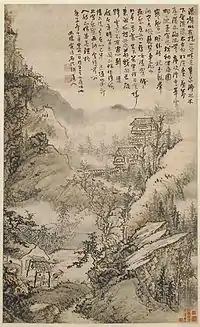Three perfections
The three perfections (Chinese: 三絕; pinyin: sānjué) is a term referring to Chinese poetry, painting, and calligraphy understood and practiced as related endeavors.

The earliest recorded mention known of "the three perfections" is found in The New Book of Tang, where the term is used to describe the work of poet-painter Zheng Qian, who, as described by calligrapher Qi Gong, "excelled in poetry, calligraphy, and painting."[1][2]
Legend holds that the Tang dynasty poets Du Fu and Li Bai were the first to introduce the combination of painting and poetry into one artwork. Several hundred years later, Su Shi, a poet and painter, promoted the use of poetry and painting together. Instruction of artists at the Northern Song Imperial Painting Academy included the integration of poetry and painting.
Examples
Gallery
._Detail%252C_Illustration_to_the_Second_Prose_Poem_on_the_Red_Cliff%252C_Nelson-Atkins_Museum_of_Art.jpg.webp)
_and_Wang_Ao_(poem)._Ode_to_Pomegranate_and_Melon_Vine._Detroit_Institute_of_Arts.jpg.webp)
References
- Words and Images: Chinese Poetry, Calligraphy, and Painting The Metropolitan Museum of Art. p. 11. Retrieved 7 July, 2022.
- The Three Perfections: Painting, Poetry and Calligraphy Long Island University. Retrieved 7 July, 2022.
Further reading
- Battista, Carolyn. (May 12, 1996). "Show of Three Perfections: Poetry, Painting and Calligraphy." The New York Times.
- Chinese Painting. Metropolitan Museum of Art.
- The Great Art of China's 'Soundless Poems'. The Schiller Institute.